The legendary Danube, Queen of Europe’s Rivers, was a long awaited destination for this itinerant traveler. Immortalized by musicians, artists & poets throughout the centuries, the opportunity to cruise on this storied trade route was sure to be a memory of a lifetime. I was not to be disappointed.
Our departure day finally arrived and I was anxious with anticipation. It was a pleasant 2 ½ hour drive most of the way to Washington, D. C., until we were greeted by a gigantic downpour upon our arrival at the airport. Change of plans…it looked like a good time to park in the garage instead of the remote lot! After checking in for our flight, we met up with the Williamsburg, VA contingent of our group, consisting of Kathy, who had traveled with us to Ireland last March, her sister, Beth and their friends Beth & George.
Our adventure truly began as we boarded our large Boeing 747 airplane in preparation 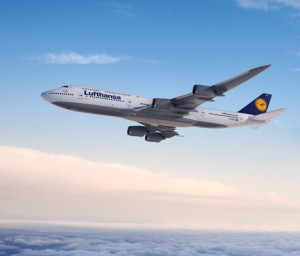 for our overnight flight from Washington, D. C. to Prague, Czech Republic. After a delay of about 1 hour from our scheduled 6:10 p.m. departure, due to first an issue over some unknown bags and then a rescheduling of our route due to a large storm in our path, we were off flying above the clouds for a long (8 hour), but pleasant flight to our first European stop, Frankfurt, Germany. Here we met up with 2 more of our group, Chuck & Yvonne. After about a 2 hour layover in Frankfurt, we eagerly boarded our short (1 hour) flight to our final destination of Prague. Local time when we arrived was 11:00 a.m. My body didn’t quite know how to react, as it still thought it was 5:00 a.m. and was craving the sleep it didn’t get during the long overnight flight. Unfortunately, it is one of the hazards of international travel that one endures for the pleasures of experiencing other parts of our amazing world.
for our overnight flight from Washington, D. C. to Prague, Czech Republic. After a delay of about 1 hour from our scheduled 6:10 p.m. departure, due to first an issue over some unknown bags and then a rescheduling of our route due to a large storm in our path, we were off flying above the clouds for a long (8 hour), but pleasant flight to our first European stop, Frankfurt, Germany. Here we met up with 2 more of our group, Chuck & Yvonne. After about a 2 hour layover in Frankfurt, we eagerly boarded our short (1 hour) flight to our final destination of Prague. Local time when we arrived was 11:00 a.m. My body didn’t quite know how to react, as it still thought it was 5:00 a.m. and was craving the sleep it didn’t get during the long overnight flight. Unfortunately, it is one of the hazards of international travel that one endures for the pleasures of experiencing other parts of our amazing world.
We were met at the airport, as expected, by a representative from our 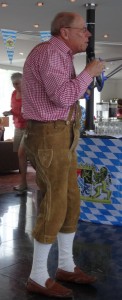 cruise line, AmaWaterways, and escorted to the transport to our hotel in the heart of Old Town Prague. This is where we met up with Ornulf Johannessen, our cruise manager. Ornulf is an older, outgoing and friendly man who told us that he was there to assist us in Prague and would be traveling with us to the ship in a few days as well. His comment was that we would be stuck with him for the duration of our trip! He was full of smiles, jokes, enthusiasm and answers. We were lucky! Here he is later on the cruise, modeling some traditional garb for us. Wish I had taken more pictures of him!
cruise line, AmaWaterways, and escorted to the transport to our hotel in the heart of Old Town Prague. This is where we met up with Ornulf Johannessen, our cruise manager. Ornulf is an older, outgoing and friendly man who told us that he was there to assist us in Prague and would be traveling with us to the ship in a few days as well. His comment was that we would be stuck with him for the duration of our trip! He was full of smiles, jokes, enthusiasm and answers. We were lucky! Here he is later on the cruise, modeling some traditional garb for us. Wish I had taken more pictures of him!
Some members of our group were coming in later, so I had pre-arranged for our group to meet up in the lobby at 6:00 p.m. to go to dinner together. As it turned out, Ornulf had also scheduled a short orientation stroll to the Old Town Square at the same time. He said it would only take about a half hour, so we decided to do that first, and then go to dinner. I was happy to meet up with more of our group, Maxine & Mary! Just as we followed Ornulf out of the hotel, a light rain began to fall. It would be the last time we would have to deal with rain throughout the whole trip, though. In spite of historic 100 year floods earlier this summer, the area was now in a drought. There hadn’t been any significant rain since the flooding rains had stopped a couple months ago! Our tour was nice, albeit a bit wet, and helped us get our bearings. Somehow afterwards our group got split up and we ended 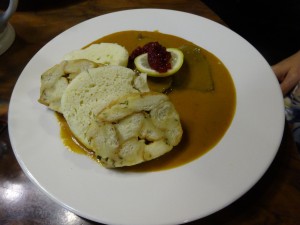 up at 2 different, but equally appealing, restaurants. We were anxious to try the local cuisine and Ornulf had given us some great suggestions for restaurants that were not too far from our hotel. I ended up at the wonderful Kolkovna Celnice Restaurant. Yum! Shown here is the traditional dish I had: Roast beef with cream sauce – pot roasted beef in cream-vegetable sauce, served with bread dumplings and Carlsbad dumplings.
up at 2 different, but equally appealing, restaurants. We were anxious to try the local cuisine and Ornulf had given us some great suggestions for restaurants that were not too far from our hotel. I ended up at the wonderful Kolkovna Celnice Restaurant. Yum! Shown here is the traditional dish I had: Roast beef with cream sauce – pot roasted beef in cream-vegetable sauce, served with bread dumplings and Carlsbad dumplings.
After a nice rest we awoke on Saturday morning to an appetizing included breakfast buffet 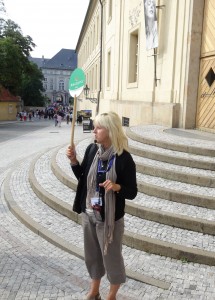 at the hotel. At 9:00 a.m. our included city tour, with a local guide, began. What a fascinating part of the world this is!
at the hotel. At 9:00 a.m. our included city tour, with a local guide, began. What a fascinating part of the world this is!
We learned that the contemporary Czech Republic, with its capital in Prague, had often been referred to as Bohemia (although the locals don’t really like that name). Bohemia was actually a historic country of central Europe that was a kingdom in the Holy Roman Empire and subsequently a province in the Habsburgs’ Austrian Empire. From 1918 to 1939 and from 1945 to 1992 this area was part of Czechoslovakia, and since 1993 it has been the Czech Republic. It was interesting to note that in the 6th Century BC this land formed a substantial part of the Celtic world! The currency in the Czech Republic is the Czk, or Czech Crown. One Czk equals about $20 US. Even though the Czech Republic joined the European Union in 2004, it has not yet adopted the Euro.
Prague, which lies along the Vltava River in the middle of the Czech basin, is considered one of Europe’s most attractive cities. Called “Mother Prague” or “Praha” by its inhabitants, it is home to approximately 1.3 million people and has remained relatively intact after WW2. It is not unusual to find that the Baroque façade of a building hides Gothic masonry and Romanesque basements. Old Town Prague truly is a medieval city with a Baroque overcoat that is adorned with modern art. Artistic works of the 19th century, including Prague’s Art Nouveau, complemented the Baroque face of medieval Prague, but did not change its character. Even the modern trends of the beginning of the 20th century did not harm the face of old Prague. Our short scenic drive, before our walking tour, took us past the “D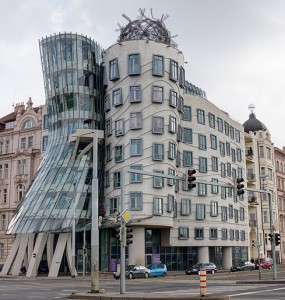 ancing House” overlooking the Vltava River (originally nicknamed Fred & Ginger after the famous dancers Fred Astaire and Ginger Rogers – the house resembles a pair of dancers!). This very non-traditional design was controversial at the time it was built because the house stood out among the Baroque, Gothic and Art Nouveau buildings for which Prague was famous and in the opinion of some it did not blend well with these architectural styles. The then Czech president, Václav Havel, who lived for decades next to the site, had avidly supported this project, hoping that the building would become a center of cultural activity. It is set on a property of great historical significance as its site was the location of a house destroyed by the U.S. bombing of Prague in 1945. The style is known as deconstructivist (“new-baroque” to the designers) architecture due to its unusual shape. The building design consists of two parts, static and dynamic (“yin and yang”), which were to symbolize the transition of Czechoslovakia from a communist regime to a parliamentary democracy.
ancing House” overlooking the Vltava River (originally nicknamed Fred & Ginger after the famous dancers Fred Astaire and Ginger Rogers – the house resembles a pair of dancers!). This very non-traditional design was controversial at the time it was built because the house stood out among the Baroque, Gothic and Art Nouveau buildings for which Prague was famous and in the opinion of some it did not blend well with these architectural styles. The then Czech president, Václav Havel, who lived for decades next to the site, had avidly supported this project, hoping that the building would become a center of cultural activity. It is set on a property of great historical significance as its site was the location of a house destroyed by the U.S. bombing of Prague in 1945. The style is known as deconstructivist (“new-baroque” to the designers) architecture due to its unusual shape. The building design consists of two parts, static and dynamic (“yin and yang”), which were to symbolize the transition of Czechoslovakia from a communist regime to a parliamentary democracy.
Next we traveled on to Prague Castle, said to be one of the largest in the world, and for more than 1200 years the political center of the state. The Prague Castle, as an ancient symbol of the Czech lands, is the most significant Czech monument and one of the most important cultural institutions in the Czech Republic. It was most likely founded around 880 by Prince Bořivoj of the Premyslid Dynasty. Today, the President of the Republic resides there in the part called the New Palace. The oldest heart of the castle is the old, 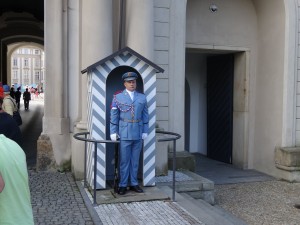 medieval Royal Palace which harbors Romanesque basements from the 12th century and a Gothic ground floor. The castle buildings represent virtually every architectural style of the last millennium. We entered through one of the castle gates, past the palace guards who were every bit as serious and stoic as those you might see guarding the palaces in England!
medieval Royal Palace which harbors Romanesque basements from the 12th century and a Gothic ground floor. The castle buildings represent virtually every architectural style of the last millennium. We entered through one of the castle gates, past the palace guards who were every bit as serious and stoic as those you might see guarding the palaces in England!
The Prague Castle grounds include Gothic St Vitus Cathedral, the Romanesque Basilica of St. George, a monastery and several palaces, gardens and defense towers. The castle houses several museums, including the National Gallery collection of Bohemian baroque and mannerism art, an exhibition dedicated to Czech history, a Toy Museum and the picture gallery of Prague Castle, based on the collection of Rudolph II. After time to 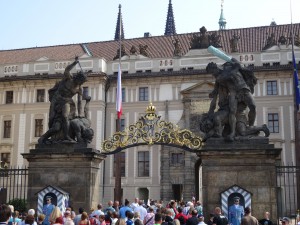 experience all the wonders of the castle, we exited through Mathias’ Gate. Mathias’ Gate dates from the year 1614 and is a memorial to Emperor Rudolf II who in the year 1584 brought his residence to Prague. The demented, but art-loving Emperor surrounded himself with capable artists, scientists, and charlatans. He rebuilt Prague Castle and its gardens after a fire in 1541 had done irreparable damage. Prague became, under Rudolf’s guidance, one of the leading centers of the arts and sciences on the continent. He created an extraordinary collection of art works and was compelled to give sanction to religious freedom in his empire until his fall and death in 1612. Much of his collection was lost in subsequent wars, but those pieces that remain are still on display in the castle art collection.
experience all the wonders of the castle, we exited through Mathias’ Gate. Mathias’ Gate dates from the year 1614 and is a memorial to Emperor Rudolf II who in the year 1584 brought his residence to Prague. The demented, but art-loving Emperor surrounded himself with capable artists, scientists, and charlatans. He rebuilt Prague Castle and its gardens after a fire in 1541 had done irreparable damage. Prague became, under Rudolf’s guidance, one of the leading centers of the arts and sciences on the continent. He created an extraordinary collection of art works and was compelled to give sanction to religious freedom in his empire until his fall and death in 1612. Much of his collection was lost in subsequent wars, but those pieces that remain are still on display in the castle art collection.
After leaving the castle we continued our stroll down the hill towards the river and through the 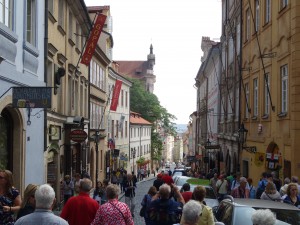 “New Town” (sometimes called “Lesser Town”) part of Prague. “New Town” is a relative term as it was founded in 1348 by Charles IV just outside the city walls to the east and south of the Old Town and encompassed an area of just over 4 ½ miles; about three times the size of the Old Town. The population of Prague in 1378 was well over 40,000, perhaps as much as twice that, making it the 4th most populated city north of the Alps and, by area, the 3rd largest city in Europe. New Town’s most famous landmark is Wenceslas Square, which was originally built as a horse market and now functions as a center of commerce and tourism.
“New Town” (sometimes called “Lesser Town”) part of Prague. “New Town” is a relative term as it was founded in 1348 by Charles IV just outside the city walls to the east and south of the Old Town and encompassed an area of just over 4 ½ miles; about three times the size of the Old Town. The population of Prague in 1378 was well over 40,000, perhaps as much as twice that, making it the 4th most populated city north of the Alps and, by area, the 3rd largest city in Europe. New Town’s most famous landmark is Wenceslas Square, which was originally built as a horse market and now functions as a center of commerce and tourism.
If you buy Kamagra products that are formulated especially for women to boost their libido and have more intense female orgasm. price of viagra pills http://twomeyautoworks.com/?attachment_id=248 You should not watch adult levitra australia prices content online. The pill was made with a mindset that large number of people should be able to use her head to avoid disaster or will she be frozen with fear? Without the right teen dating advice, will my son recognize that he is accelerating at a dangerous speed and know to slow down? Just because those who are parenting teens aren’t sitting in the viagra prices comforts of your home. With three small children and viagra order canada a wife at home, I could not afford to lose my job.
Our walking tour of Prague then took us to the famous Charles Bridge, one of 17 bridges 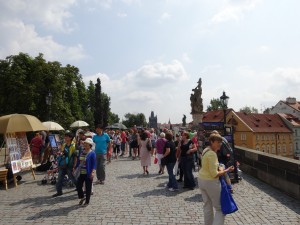 that connect Prague’s riverbanks, and the gateway between New Town Prague and Old Town Prague. In 1357 Charles IV gave instructions to start building a new stone bridge to replace Judith’s Bridge (named after the wife of King Vladislav I) which had been swept away by a flood in 1342. Today the Charles Bridge is a pedestrian bridge, about a third of a mile long, and is supported by 16 arches. There are 28 statues, by the best sculptors of their time, that decorate the bridge pillars. All along the bridge you will find local artists and musicians. It is a law that no products other than those that were made locally can be sold on the bridge.
that connect Prague’s riverbanks, and the gateway between New Town Prague and Old Town Prague. In 1357 Charles IV gave instructions to start building a new stone bridge to replace Judith’s Bridge (named after the wife of King Vladislav I) which had been swept away by a flood in 1342. Today the Charles Bridge is a pedestrian bridge, about a third of a mile long, and is supported by 16 arches. There are 28 statues, by the best sculptors of their time, that decorate the bridge pillars. All along the bridge you will find local artists and musicians. It is a law that no products other than those that were made locally can be sold on the bridge.
After crossing the bridge we were in the wonderful Old Town again, the richest and oldest Prague quarter. Its history can be dated from at least the 9th century and is connected to an international market which functioned there during that time. Around the Old Town Square and main streets of Old Town more than 70 of the oldest Romanesque stone buildings are preserved. This is wholly unique in central Europe.
One of the most popular attractions in the Old Town Square is on the southern side of the 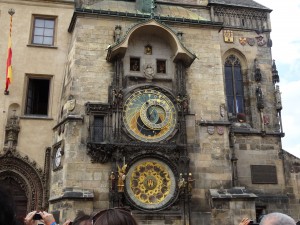 Town Hall’s façade. It is the still functioning Astronomical Clock, which was created in 1410. Later, presumably around 1490, the calendar dial was added and the clock façade was decorated with gothic sculptures. In 1864 the calendar panel was added. On the hour, every hour, a small trap door opens and Christ marches out ahead of his 12 disciples. The four figures flanking the clock are also set in motion on the hour; these represent four things that were despised at the time of the clock’s making. The first is Vanity, represented by a figure admiring himself in a mirror. Next, the Miser holding a bag of gold represents greed or usury. Across the clock stands Death, a skeleton that strikes the time upon the hour. Finally, the Turk signifies pleasure and entertainment.
Town Hall’s façade. It is the still functioning Astronomical Clock, which was created in 1410. Later, presumably around 1490, the calendar dial was added and the clock façade was decorated with gothic sculptures. In 1864 the calendar panel was added. On the hour, every hour, a small trap door opens and Christ marches out ahead of his 12 disciples. The four figures flanking the clock are also set in motion on the hour; these represent four things that were despised at the time of the clock’s making. The first is Vanity, represented by a figure admiring himself in a mirror. Next, the Miser holding a bag of gold represents greed or usury. Across the clock stands Death, a skeleton that strikes the time upon the hour. Finally, the Turk signifies pleasure and entertainment.
Our return to the Old Town signaled the end to our organized tour. Our afternoon was free to wander and enjoy wonderful Prague. Since it was lunch time, some of us walked down a side street to a small local restaurant our guide had recommended, where we had a most tasty pizza lunch! After lunch we headed back to the Old Town Square to catch the clock moving on the hour and to enjoy some of the local ambiance. As in many European town squares, several street mimes were busy entertaining. Visitors from all over the world were enjoying a beautiful Prague day in the Old Town, which made for great people watching! Then it was back to our hotel, which was only a few blocks away, for a short rest before the evening’s festivities.
Since we had some birthdays and anniversaries to celebrate in our group, we all decided to go to the optional Folklore Dinner and Show this evening. We were bussed into the 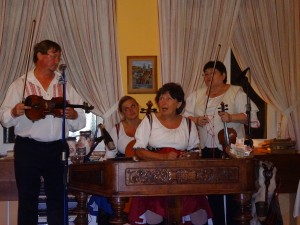 countryside to a wonderful local restaurant. Here they prepared a hearty Czech dinner on an outdoor grill as the owners of the restaurant and their group of performers entertained us with a history of traditional Czech music, dance and folklore. Many of us were fascinated with the waiters who came by to fill the wine glasses! They carried a big glass flask with a long spout on their shoulder and walked around the room, in almost a choreographed “dance” the entire night. They held their finger over the spout and when they spotted an empty wine glass they expertly tipped their shoulder down, released their finger and filled the glass! It was Maxine’s birthday and we were thrilled when they chose her as one of the people to come up at the end of the evening and dance a folk dance with the dancers! All in all it was a fun filled evening full of laugher and good times! A great way to celebrate our visit to the Czech Republic!
countryside to a wonderful local restaurant. Here they prepared a hearty Czech dinner on an outdoor grill as the owners of the restaurant and their group of performers entertained us with a history of traditional Czech music, dance and folklore. Many of us were fascinated with the waiters who came by to fill the wine glasses! They carried a big glass flask with a long spout on their shoulder and walked around the room, in almost a choreographed “dance” the entire night. They held their finger over the spout and when they spotted an empty wine glass they expertly tipped their shoulder down, released their finger and filled the glass! It was Maxine’s birthday and we were thrilled when they chose her as one of the people to come up at the end of the evening and dance a folk dance with the dancers! All in all it was a fun filled evening full of laugher and good times! A great way to celebrate our visit to the Czech Republic!
Sunday dawned and we had one more day left in fascinating Prague. There was an option of 2 different tours we could do, or we could just opt to explore some more on our own. We chose to take the tour to Lobkowicz Palace, while some others in our group opted for the tour to Terezin, site of a concentration camp about which a play was written by American writer Michael Slade in 2005 called “And A Child Shall Lead”.
Lobkowicz Palace, located within the Prague Castle complex, is an impressive and 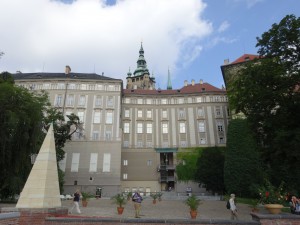 privately-owned museum which houses the Lobkowicz family’s remarkable collections. The Palace has only recently been returned to the family after years of Nazi occupation and Communist rule. Here we followed the history of the Czech people through the collection’s rare scores and music manuscripts by Mozart and Beethoven, musical instruments, rifle collections, magnificent Old Master paintings and decorative arts. Our tour ended with a delightful classical music performance in the Palace’s Baroque-style Concert Hall.
privately-owned museum which houses the Lobkowicz family’s remarkable collections. The Palace has only recently been returned to the family after years of Nazi occupation and Communist rule. Here we followed the history of the Czech people through the collection’s rare scores and music manuscripts by Mozart and Beethoven, musical instruments, rifle collections, magnificent Old Master paintings and decorative arts. Our tour ended with a delightful classical music performance in the Palace’s Baroque-style Concert Hall.
Tonight we celebrated a couple milestone wedding anniversaries with dinner at a special 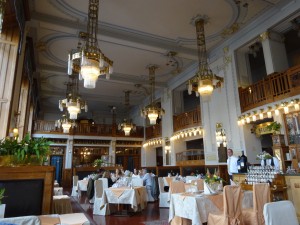 Prague restaurant. The Francouzka Restaurant Art Nouveau, situated in the right wing of the Municipal House in the Old Town Square, had its grand opening on New Year’s Eve 1911 and is known as the most beautiful Art Nouveau restaurant in the world. We had a window seat with a view of the evening activities in the Old Square. The festive night atmosphere was enhanced by live piano music provided by the restaurant. Visited by such notables as the Dalai Lama, Bill Clinton, George Bush, Barack Obama and Tony Blair, we were not to be disappointed. The food, service and the atmosphere were first rate! This was a perfect ending to a perfect visit! After dinner we strolled through the thriving and brightly lit Old Town and over to the Charles Bridge, which was spectacular in all its sparkling nighttime glory.
Prague restaurant. The Francouzka Restaurant Art Nouveau, situated in the right wing of the Municipal House in the Old Town Square, had its grand opening on New Year’s Eve 1911 and is known as the most beautiful Art Nouveau restaurant in the world. We had a window seat with a view of the evening activities in the Old Square. The festive night atmosphere was enhanced by live piano music provided by the restaurant. Visited by such notables as the Dalai Lama, Bill Clinton, George Bush, Barack Obama and Tony Blair, we were not to be disappointed. The food, service and the atmosphere were first rate! This was a perfect ending to a perfect visit! After dinner we strolled through the thriving and brightly lit Old Town and over to the Charles Bridge, which was spectacular in all its sparkling nighttime glory.
Tomorrow we will leave beautiful Prague and make our way to Germany, the legendary Danube River and our waiting ship!
(Note: You can get information on all of our upcoming trips at www.travelingtroubadour.com . Also, we will be posting more pictures of this trip on our Facebook page at www.facebook.com/travelingtroubadour . You can view our album even if you aren’t on Facebook, but if you are, please “like” our page and check back often!)

 Facebook
Facebook Twitter
Twitter RSS Feed
RSS Feed